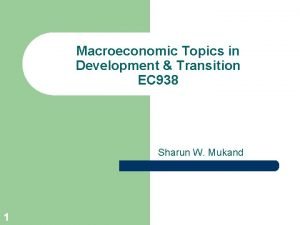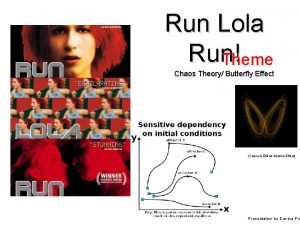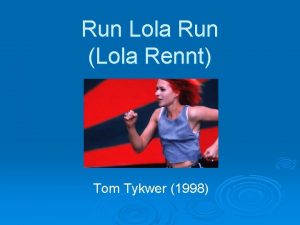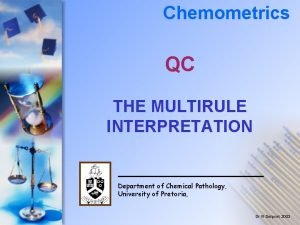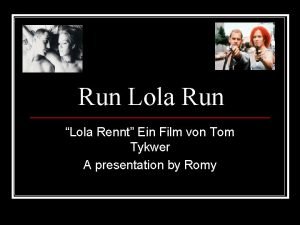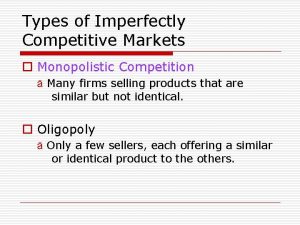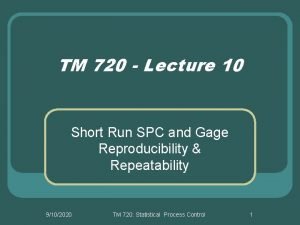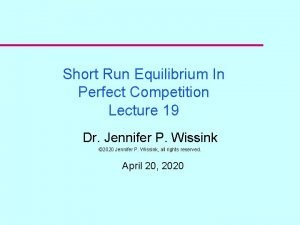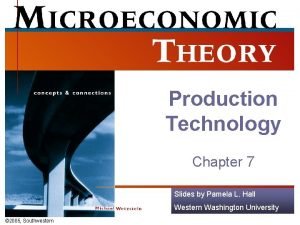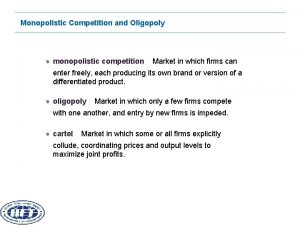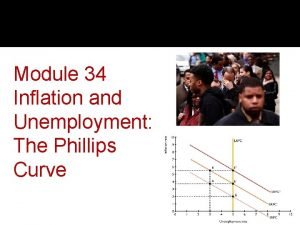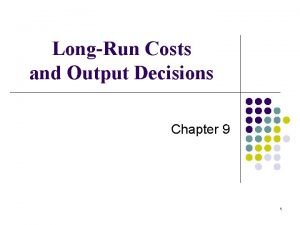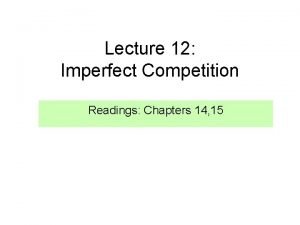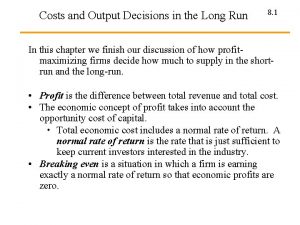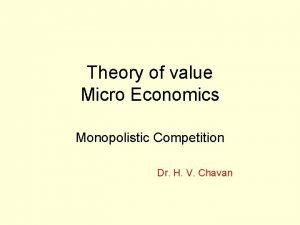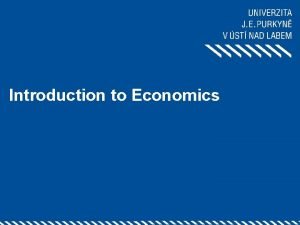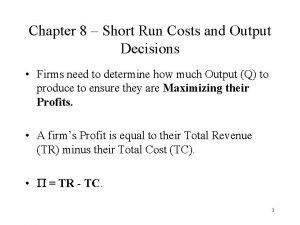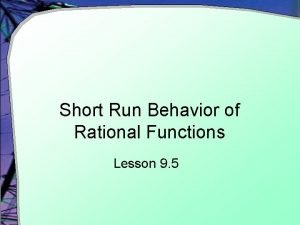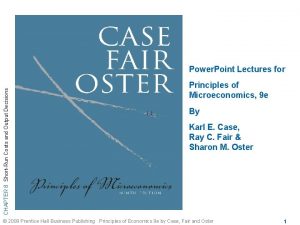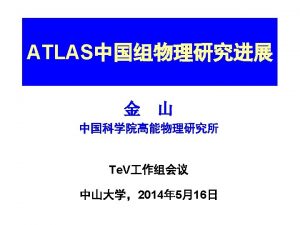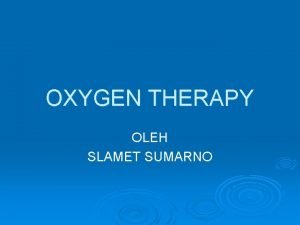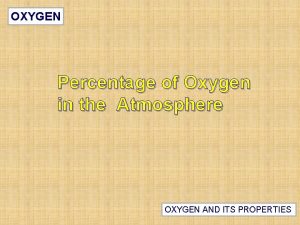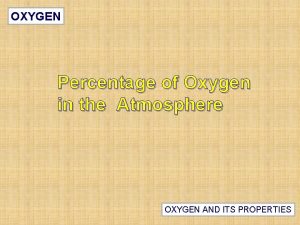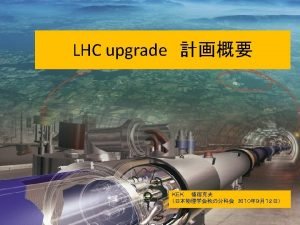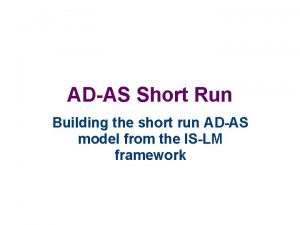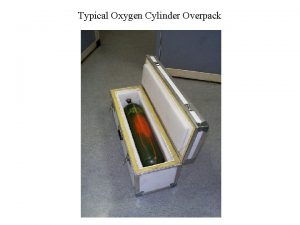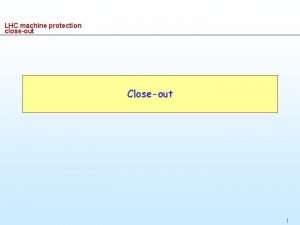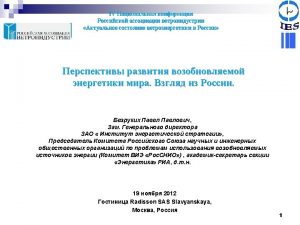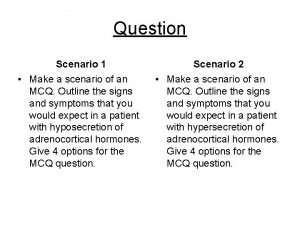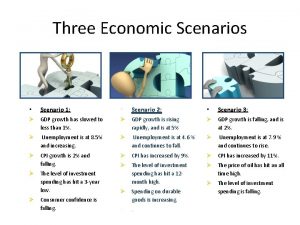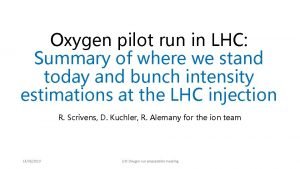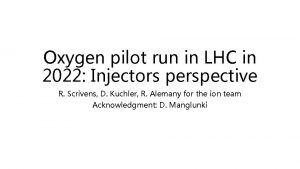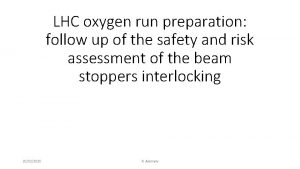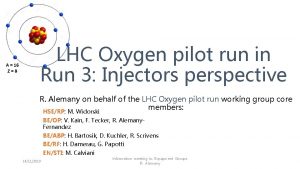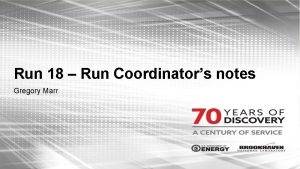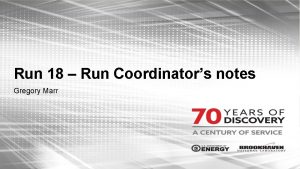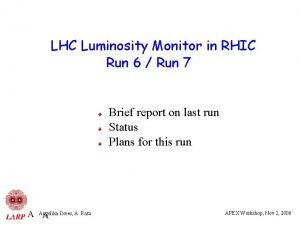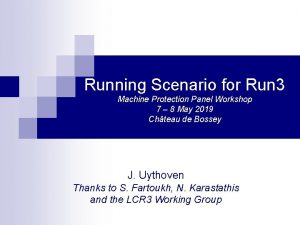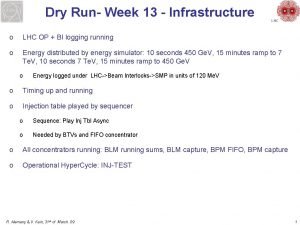LHC machine scenario for a short oxygen run




































- Slides: 36

LHC machine scenario for a short oxygen run R. Bruce, R. Alemany Fernandez, H. Bartosik, M. Jebramcik, J. M. Jowett, M. Schaumann

Outline • Introduction • Requests and constraints • Options for machine configuration • Needed machine commissioning • Luminosity simulations and performance estimates – O-O – p-O • First thought on schedule • Uncertainties and complications • Conclusions R. Bruce, 2021. 02. 10 2

History of nuclear beams in the LHC Xe-Xe pilot run • Most years LHC operated 1 month per year with nuclear beams Partially stripped Pb 81+ pilot run • 2017: Did a short pilot run with Xe-Xe collisions Pilot run – So far used Pb -Pb or p-Pb – In total, 6 runs so far p-Pb @ 4 Z Te. V Pb-Pb @ 3. 5 Z Te. V p-Pb @ 6. 37 Z Te. V Pb-Pb @ 6. 37 Z Te. V R. Bruce, 2021. 02. 10 3

Future operation with nuclear beams • Heavy-ion runs scheduled to continue until end of Run 4 with Pb. Pb and p-Pb • No officially approved program for Run 5 and beyond, but strong interest from experiments • HL/HE-LHC physics workshop considered high-intensity operation with lighter species beyond Run 4 – Motivation is higher nucleon-nucleon luminosity than Pb-Pb – See yellow report (input to European strategy) – Physics interest to fill in gaps with intermediate systems R. Bruce, 2021. 02. 10 4

Future plans for LHC / HL-LHC From O. Bruning R. Bruce, 2021. 02. 10 5

Future light-ion operation • Also requested pilot-like O-O and p-O run – Much earlier (Run 3), a few days, low luminosity – Different motivations: O-O intermediate system (as Xe-Xe since QM 2018) – p-O requested by cosmic ray community for several years – Not necessarily a prelude to Run 5 light-ion physics interest – A pilot run would be very useful to understand limitations and performance in the injectors and LHC, in view of Run 5 high-intensity operation • This pilot run discussed previously at the LMC and LPC • Previous pilot runs very successful R. Bruce, 2021. 02. 10 6

Previous pilot runs • Two previous pilot runs of LHC with new colliding species : – p-Pb in 2012 – discoveries – Xe-Xe in 2017 – results at Quark Matter 2018 – very successful both operationally and in terms of physics output Reminder: 2017 Xe-Xe run References at IPAC 2018 https: //accelconf. web. cern. c h/Accel. Conf/ipac 2018/ MOPMF 039 First Xenon Collisions in the LHC MOPMF 038 Cleaning Performance of the Collimation System with Xe Beams at the Large Hadron Collider TUPAF 020 Performance of the CERN Low Energy Ion Ring (LEIR) with Xenon TUPAF 024 Impedance and Instability Studies in LEIR With Xenon Data on Xe-Xe data features in very large number of papers since 2018 This run used p-p optics for fast set-up ALICE had β*=10 m so lower luminosity than ATLAS/CMS. Avoid this in future O-O run prefer to use a heavy-ion optics.

Constraints and requests for oxygen in Run 3 • It should be a short run, ideally not more than about a week • Requests for both O-O and p-O – LHCb requests p in beam 1 – No request to reverse, i. e. O-p not requested • Luminosity targets: (from B. Petersen at LMC) – O-O: ~0. 5/nb for soft physics program, ~2/nb equivalent to 2010 Pb. Pb run for hard-probes – p-O: LHCb would like >2/nb, LHCf would like ~1. 5/nb – LHCf requests low pileup of 0. 02 in p-O (update: previously 0. 01) – ALICE wants low pileup of 0. 1 -0. 2 • Beam energy: – Previously assumed same energy per charge as main Pb run (probably 7 Z Te. V) – Some wishes from experiments for same energy per nucleon as for Pb-Pb (i. e. 5. 52 Z Te. V if Pb-Pb runs are done at 7 Z Te. V), or at 5. 02 Z Te. V to match the existing pp, Pb and p-Pb datasets R. Bruce, 2021. 02. 10 8

Heavy-ion and pp ref energies/Te. V Energies that have been used in heavy-ion and pp reference runs since 2012 (colours) or that might be considered for the future (black). Efficient OO/p. O options for Run 3. Operational preference for all runs in Run 3 (and/or Run 4) to be made at same beam R. Bruce, 2021. 02. 10 rigidity (first column). 9

So what oxygen levels could we get in the LHC? R. Bruce, 2021. 02. 10 10

Potential machine scenarios • How can we combine these constraints to a realistic machine scenario? – To fit in about a week, need to minimize commissioning • Scenario 1: use “EARLY” ion beam with single injections, (see talk R. Alemany) at standard Run 3 beam energy (7 Z Te. V or maybe 6. 37 Z Te. V) – keep total charge per beam below 3 x 1011 => allows “light” machine validation – Reuse machine settings from previous Pb-Pb or p-p run to minimize commissioning • use the same optics cycle, and therefore same rigidity as in the other HI runs in Run 3 • Pb-Pb cycle preferred – much smaller β* in ALICE. Could use identical or similar combined ramp and squeeze to 2018 • Scenario 2: use “EARLY” ion beam with single injections, (see talk R. Alemany) at same energy per nucleon as Pb-Pb (probably 5. 52 Z Te. V) – keep total charge per beam below 3 x 1011 => allows “light” machine validation – Cannot reuse previous machine settings – need to commission new cycle • Scenario 3: Use high intensity with trains, “NOMINAL” beam at 7 Z Te. V – We cannot mask interlocks and need a full machine recommissioning and validation – We could potentially reuse the previous cycle R. Bruce, 2021. 02. 10 11

Needed commissioning – first estimates Scenario 1: Assuming same energy per charge as in Pb-Pb, probably 7 Z Te. V • O-O commissioning – Recheck entire cycle: orbit, tune, Q’, coupling collisions, optics @ low beta – 3 shifts. • Time estimate based on the fact that optics reproducible • Could do it with protons – Clean-up the cycle with new settings (assume optics is stable !) – 1 shift. • Might need some additional time for BPM setup if using bunch charge around 4 E 10 – Setup of injection and capture – 1 shift – Validation • 1 shift for tertiary collimators (if needed), and loss maps + asynch dump test • Low-intensity setup beam with bunch spacing > abort gap: do asynch dump test only at injection and collision (TBC with MP and ABT) – Total time 6 shifts ~2 -3 days • p-O commissioning – Setup of injection frequencies, p-beam, cogging – 1 shift – Validation - 0. 5 shift. Use cogging fill? – Sufficient with p-O (O-p not requested) – Total time ~2 shifts ~0. 5 -1 day • The above estimates assume that the LHC machine and injectors are available – we could potentially lose time in case of faults R. Bruce, 2021. 02. 10 12

Extra time needed in other scenarios • Scenario 2: For a lower beam energy: 5. 52 Z Te. V or 5. 02 Z Te. V – Need to commission new machine cycle: cut existing ramp at lower energy, add new squeeze • Achievable β*-value to be verified – Needed commissioning in addition to scenario 1 • • 2 -3 shifts for optics commissioning 1 shift collimator alignment 1 shifts for additional qualification In total 4 -5 extra shifts – In addition: lower luminosity expected => need more time for data taking. See later • Scenario 3: For higher intensity (>3 E 11 charges, “NOMINAL” beam) at 7 Z Te. V – Need full qualification, all interlocks active – Extra commissioning compared to scenario 1 • 1 shift for collimator alignment • 1 shift for generation of new settings, cycle with new settings • 2 shifts for qualification To be done for both O-O and p-O – In total about 3 days more commissioning + contingency – In addition, intensity rampup needed before we arrive at top intensity • Took about 3. 5 days in the 2018 Pb-Pb run – This scenario does not seem suitable for a 1 -week run. Could reconsider if more time is allocated. • Given the 1 -week target, the most realistic option is to stay with the previous cycle at 7 Z Te. V (scenario 1) R. Bruce, 2021. 02. 10 13

Outline • Introduction • Requests and constraints • Options for machine configuration • Needed machine commissioning • Luminosity simulations and performance estimates – O-O – p-O • First thought on schedule • Uncertainties and complications • Conclusions R. Bruce, 2021. 02. 10 14

Assumptions: O-O • Consider scenarios 1 (7 Z Te. V) and 2 (5. 52 Z Te. V) for detailed simulations of luminosity performance • Expected beams from injectors (see talk R. Alemany) – Significant uncertainty on achievable emittance and intensity – Assume same emittance as for Pb (2. 1 μm) – Two options for intensity: • 3. 97× 1010 charges/bunch (4. 96× 109 O 8+ ) can be handled in the SPS • We have to split these bunches in 2 to avoid SPS losses – Assume 7% intensity loss between injection in the LHC and collisions • Machine optics – Scenario 1, at 7 Z Te. V: identical β*=(0. 5, 1. 5) to 2018 – Scenario 2, at 5. 52 Z Te. V: assume 0. 65 m instead of 0. 5 m from aperture scaling • Crossing angles as assumed for Run 3 Pb-Pb – In principle no crossing needed, but removing it would cost some commissioning time. Possible optimization to be studied R. Bruce, 2021. 02. 10 15

Assumed parameters, O-O, scen. 1 Beam parameters Without SPS split Beam energy (Z Te. V) With SPS split 7 7 3. 5 6 12 O ions per bunch 4. 6× 109 2. 3× 109 Charges per bunch 3. 7× 1010 1. 8× 1010 2. 1* 2. 4× 1011 Beam energy per nucleon (Te. V) Number of bunches Normalized emittance (μm) Total charges per beam *We don’t know – this is a guess IP parameters IP 1/5 IP 2 IP 8 0. 5 1. 5 External half crossing [μrad] 170 -170 Total half crossing [μrad] 170 100 -305 N. o. collisions (no split, split) 4, 8 Peak luminosity [1027 cm-2 s-1] (no split, split) 21. 1, 10. 6 6. 7*, 12. 3 6. 9, 3. 5 Peak pileup (no split, split) 0. 63, 0. 18 0. 20*, 0. 18 0. 21, 0. 05 *levelled 16

Simulation setup • Burnoff cross sections – hadronic interactions dominate for oxygen operation Pb-Pb p-Pb O-O p-O Bound-free pair production(barn) 281 0. 044 < 0. 01 <10 -5 Electromagnetic dissociation (barn) 226 0. 035 0. 133 0. 0012 Hadronic cross section Total cross section 8 2. 12 1. 343* 0. 45** 515 2. 20 1. 48 0. 45 * Glauber calculation by G. Contreras ** Glauber calculation by David d’Enterria • Luminosity in one fill simulated with two independent simulation codes – CTE and MBS – see CERN-ACC-2020 -0011 – Simulates coupled beam evolution under influence of e. g. collisions, intrabeam scattering, radiation damping – Non-collisional lifetime of 50 h assumed – possibly pessimistic, but cannot count on fully optimized machine R. Bruce, 2021. 02. 10 17

Simulation benchmark CTE simulation vs measurements of fill 7477, Pb-Pb @6. 37 Z Te. V, 2018 R. Bruce, 2020. 07. 21 18

Results: O-O Instantaneous luminosity rio 1 rio 2 a en c S na e c S R. Bruce, 2021. 02. 10 19

Results: O-O Integrated luminosity rio 1 rio 2 a en c S na e c S R. Bruce, 2021. 02. 10 20

Observations O-O • Scenario 1: At 7 Z Te. V, to accumulate 0. 5 nb-1 in single, long fill: – – ATLAS/CMS need ~8 h for 6 b and ~19 h with 12 b ALICE needs ~21 h with 6 b and ~13 h with 12 b LHCb: Could reach ~0. 3 nb-1 in single long fill of ~20 h Of course, the fill might be dumped earlier, and we make a second fill • Scenario 2: At 5. 52 Z Te. V, to accumulate 0. 5 nb-1 : – ATLAS/CMS need ~16 h for 6 b and >40 h for 12 b – ALICE needs ~22 h with 6 b and ~39 h with 12 b • Clear risk that we need significantly longer running time if we go for 5. 52 Z Te. V, which comes on top of the additional commissioning – Need >1 day longer running than at 7 Z Te. V if we’re forced to use the 12 -bunch scheme R. Bruce, 2021. 02. 10 21

Assumptions: p-O • Consider scenarios 1 (7 Z Te. V) and 2 (5. 52 Z Te. V) for detailed simulations of luminosity performance • For LHCf, where pileup = 0. 02 is requested: need to split beam in more bunches to make luminosity goal feasible – Assume 36 bunches, with 24 colliding at each IP – Level LHCf at 1. 2× 1028 cm-2 s-1 : expect just below 40 h to reach 1. 5 nb-1 – Upper intensity limit on both O and p beams given by max allowed total intensity of 3 E 11 charges – Need ~10% margin at injection, since we cannot control the intensity better shot-by-shot – Assume 7% intensity loss between injection in the LHC and collisions • Same machine optics and crossing angles as for O-O R. Bruce, 2021. 02. 10 22

Assumed parameters, p-O, scen. 1 Beam parameters Protons Oxygen Beam energy (Z Te. V) 7 7 Beam energy per nucleon (Te. V) 7 3. 5 Number of bunches 36 36 Particles per bunch 7× 109 8. 7× 108 Charges per bunch 7× 109 2. 5 2. 1* 2. 5× 1011 Normalized emittance (μm) Total charges per beam *We don’t know – this is a guess IP parameters IP 1/5 IP 2 IP 8 0. 5 1. 5 External half crossing [μrad] 170 -170 Total half crossing [μrad] 170 100 -305 N. o. collisions 24 24 24 45 (12*) 53 15 0. 075 (0. 02*) 0. 08 0. 025 Peak luminosity [1027 cm-2 s-1] Peak pileup (no split, split) * For IP 1 levelled to 0. 02 pileup 23

Results: p-O Instantaneous luminosity Scenario 1 Integrated luminosity LHCb target LHCf target Scenario 2 LHCb target LHCf target R. Bruce, 2021. 02. 10 24

Observations p-O • Need ~36 h in stable beams to give 1. 5 nb-1 to LHCf at pileup=0. 02 • Scenario 1: At 7 Z Te. V, LHCb target of 2 nb-1 can be reached in 3 fills of about 15 -16 h each (optimum fill length for IP 8) + turnaround – Total time needed: 2. 5 days without contingency – Future study: Can we optimize the filling scheme further to give more collisions to LHCf and LHCb? – In those 3 fills CMS and ALICE could hope for some 6 -7 nb-1 – LHCf would be at about 2 nb-1 – Still might need some additional contingency • Scenario 2: At 5. 52 Z Te. V, LHCb needs an additional ~15 h of stable beams to reach 2 nb-1 (need to add some hours for turnaround) R. Bruce, 2021. 02. 10 25

First thoughts on tentative schedule For scenario 1: Same beam energy as in Pb-Pb, probably 7 Z Te. V • O-O commissioning: 2 -3 days • O-O physics run: 1 day – Goal: above 0. 5 nb-1 in ALICE, ATLAS, CMS. • p-O commissioning: 0. 5 – 1 day • p-O physics run: 2. 5 -3 days – Goal: above 1. 5 nb-1 in LHCf and 2 nb-1 in LHCb • Total: ~6 -8 days – Less physics time would still be useful For scenario 2 (5. 52 ZTe. V): • add 2 -3 days of commissioning and 1 -2 days of physics R. Bruce, 2021. 02. 10 26

Outline • Introduction • Requests and constraints • Options for machine configuration • Needed machine commissioning • Luminosity simulations and performance estimates – O-O – p-O • First thought on schedule • Uncertainties and complications • Conclusions R. Bruce, 2021. 02. 10 27

Uncertainties and complications • Large uncertainty on emittance and bunch intensity from injectors – Presented performance could go in both directions • Assuming a good machine availability – any major fault in the LHC or the injectors would cause additional delays • Oxygen beam transmutation effect under study – could potentially pollute the collisions R. Bruce, 2021. 02. 10 28

Transmutation of O beam • Electromagnetic dissociation and hadronic interactions in collisions can create nuclei with A=2 Z, like initial 16 O 8+ and with small momentum recoil. • Rigidity shift is small so they can potentially stay in beam. (%) from mass only Very(!) preliminary estimates of upper limit based on: EMD cross sections (RELDIS), rough approximations for hadronic contributions, luminosity evolution data. Collimation system can remove some but not all of these nuclei. Potential pollution of few % of O beam population by lighter nuclei, esp 14 N, . Collisions between, eg, C-O difficult to distinguish from peripheral OO events. J. M. Jowett, S. Klein, E. Pshenichnov, A. Dainese, R. Bruce, 2021. 02. 10 29

Conclusions • Studied various options for a short LHC run, of about 1 week, with O-O and p-O – Motivated both by physics interest and for studying the machine performance in view of future light-ion operation – Most efficient option is to re-use the machine cycle of the previous Pb-Pb run at the same beam energy (possibly 7 Z Te. V), using pilot beams with single injections (below 3× 1011 charges per beam) • For this option, estimated ~2. 5 -4 days of commissioning and 3. 5 -4 days of running to reach luminosity goals – Assuming good machine availability – any long faults will extend the schedule – Large uncertainties on beam parameters apply – performance and hence needed time directly affected • If we run at lower energy, e. g. at 5. 52 Z Te. V, expect some 3 -5 days more total time • Points for further study – Optimization of filling schemes – Oxygen beam transmutation effect R. Bruce, 2021. 02. 10 30

Thanks for the attention! Questions? R. Bruce, 2021. 02. 10 31

Backup R. Bruce, 2021. 02. 10 32

Results: O-O Beam evolution R. Bruce, 2021. 02. 10 33

Results: p-O Beam evolution R. Bruce, 2021. 02. 10 34

O beam transmutation • Broad spectrum of fragments created in nuclear collisions. Usually fragments cannot stay in the ring due to their charge-to-mass ratio • New effect recently predicted: Nuclear breakup in oxygen collisions create fragments with the same charge-to-mass ratio as the main 16 O 8+ ions, e. g. 4 He 2+, 6 C 12, 14 N 7+ • These ions could potentially stay in the beam and pollute the collisions – To be investigated: are the kicks in energy and momentum from the scattering enough to make these particles impact on the aperture or collimators • Effect is under study and the impact is still to be quantified R. Bruce, 2021. 02. 10 35

Integrated Pb-Pb luminosity per fill • Showing ratio of simulated/measured integrated luminosity in 30 stable-beam fills from 2018 • In general very good agreement – Large spread at LHCb not well understood. LHCb experts have doubts on the cross sections used for calibration Ratio Sim. /Meas. Mean Std. dev. ATLAS 1. 00 0. 03 ALICE 1. 01 0. 04 LHCb 1. 02 0. 12 R. Bruce, 2020. 05 36
 Tall+short h
Tall+short h Long run in perfect competition
Long run in perfect competition Short run vs long run economics
Short run vs long run economics Perfect competition short run and long run
Perfect competition short run and long run Themes in run lola run
Themes in run lola run Run lola run editing techniques
Run lola run editing techniques Within run and across run meaning
Within run and across run meaning Run lola run script
Run lola run script Nn lolas
Nn lolas Excess capacity micro
Excess capacity micro Short run spc
Short run spc Short run philips curve
Short run philips curve What does the short run phillips curve show
What does the short run phillips curve show Recessionary gap phillips curve
Recessionary gap phillips curve Short run supply curve
Short run supply curve Three stages of short run production function
Three stages of short run production function Monopolistic competition short run
Monopolistic competition short run Expected vs actual inflation phillips curve
Expected vs actual inflation phillips curve Long run shut down
Long run shut down Monopolistic competition short run
Monopolistic competition short run Short run supply curve for a perfectly competitive firm
Short run supply curve for a perfectly competitive firm Short run supply curve for a perfectly competitive firm
Short run supply curve for a perfectly competitive firm Economists group industries into distinct market structures
Economists group industries into distinct market structures Perfectly competitive short run supply curve
Perfectly competitive short run supply curve Macroeconomic equilibrium occurs:
Macroeconomic equilibrium occurs: Contractionary fiscal policy interest rate
Contractionary fiscal policy interest rate Long run economic growth graph
Long run economic growth graph Monopolistic competition short run
Monopolistic competition short run Short run equilibrium under perfect competition
Short run equilibrium under perfect competition Shutdown point economics
Shutdown point economics Short run cost and output decisions
Short run cost and output decisions Downward sloping demand curve
Downward sloping demand curve Short run shutdown point
Short run shutdown point Long run behavior of rational functions
Long run behavior of rational functions Total variable cost curve
Total variable cost curve Short run trade off
Short run trade off Cost output relationship
Cost output relationship


